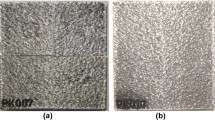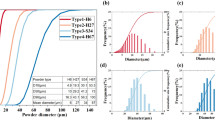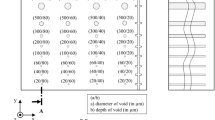Abstract
In order to develop smart laser powder bed fusion (LPBF) devices that autonomously identify a defect and remove it during the process for first-time-right and zero-defect parts, it is important to develop reliable on-machine defect measuring capabilities. As defects in LPBF parts often occur below the layer that is being processed, capturing the information of a printing layer may not give information about physical phenomena that are occurring below this layer. Therefore, to predict volumetric features such as porosity only by looking at the layer being processed, the correlation between process signatures identified in-process and defects measured via post-process inspection methods (for example X-ray computed tomography) needs to be conducted. Hence, in situ monitoring and post-process metrology form a basis to better understand the fundamental physics involved in an LPBF process and ultimately to determine its stability. By utilizing high-speed imaging, various process signatures are produced during single-track formation of 316L stainless steel with various combinations of laser power and scan speed. In this study, we evaluate whether these signatures can be used to detect the onset of potential defects. To identify process signatures, image segmentation and feature detection are applied to the monitoring data along the line scans. The process signatures determined in the current study are mainly related to the features like the process zone length-to-width ratio, process zone area, process zone mean intensity, spatter speed and number of spatters. It is shown that the scan speed has a significant impact on the process stability and spatter formation during single-track fusion. Simulations with similar processing conditions were also performed to predict melt pool geometric features. Post-process characterization techniques such as X-ray computed tomography and 2.5-D surface topography measurement were carried out for a quality check of the line track. An attempt was made to correlate physics-based features with process-related defects and a correlation between the number of keyhole porosities, and the number of spatters was observed for the line tracks.
Graphical abstract
















Similar content being viewed by others
References
Hooper PA (2018) Melt pool temperature and cooling rates in laser powder bed fusion. Addit Manuf 22:548–559
Booth BG, Heylen R, Nourazar M et al (2022) Encoding stability into laser powder bed fusion monitoring using temporal features and pore density modelling. Sensors 22:3740
Thanki A, Goossens L, Ompusunggu AP et al (2022) Melt pool feature analysis using a high-speed coaxial monitoring system for laser powder bed fusion of Ti-6Al-4 V grade 23. Int J Adv Manuf Technol 120:6497–6514
Bisht M, Ray N, Verbist F, Coeck S (2018) Correlation of selective laser melting-melt pool events with the tensile properties of Ti-6Al-4V ELI processed by laser powder bed fusion. Addit Manuf 22:302–306
Buls S, Clijsters S, Kempen K, Kruth J-P (2014) Melt pool system identification and feedback control for selective laser melting. 6th international PMI conference, Guimares, Portugal 345–348
Clijsters S, Craeghs T, Buls S et al (2014) In situ quality control of the selective laser melting process using a high-speed, real-time melt pool monitoring system. Int J Adv Manuf Technol 75:1089–1101
Steen WM, Mazumder J (2010) Laser material processing. Springer Verlag, London
Ion John C (2005) Laser processing of engineering materials. Elsevier
Ye D, Fuh JYH, Zhang Y et al (2018) In situ monitoring of selective laser melting using plume and spatter signatures by deep belief networks. ISA Trans 81:96–104
Kivirasi E, Piili H, Minet-Lallemand K, Kotila J (2020) Detecting spattering phenomena by using high speed imaging in L-PBD of 316 L. Procedia CIRP 94:398–403
Wang D, Wu S, Fu F et al (2017) Mechanisms and characteristics of spatter generation in SLM processing and its effect on the properties. Mater Des 117:121–130
Young ZA, Guo Q, Parab ND et al (2020) Types of spatter and their features and formation mechanisms in laser powder bed fusion additive manufacturing process. Addit Manuf 36:101438
Matthews MJ, Guss G, Khairallah SA, et al (2017) Denudation of metal powder layers in laser powder-bed fusion processes. In: Additive Manufacturing Handbook. CRC Press, pp 677–692
Haehnel R, Dade WB (2008) Physics of particle entrainment under the influence of an impinging jet. US Army Reseach and Engineering laboratory Hanover
Syed AA, Denoirjean A, Fauchais P, Labbé J-C (2006) On the oxidation of stainless steel particles in the plasma jet. Surf Coat Technol 200:4368–4382
Simonelli M, Tuck C, Aboulkhair NT et al (2015) A study on the laser spatter and the oxidation reactions during selective laser melting of 316L stainless steel, Al-Si10-Mg, and Ti-6Al-4V. Metall Mater Trans A 46:3842–3851
Mumtaz KA, Hopkinson N (2010) Selective laser melting of thin wall parts using pulse shaping. J Mater Process Technol 210:279–287
Liu Y, Yang Y, Mai S et al (2015) Investigation into spatter behavior during selective laser melting of AISI 316L stainless steel powder. Mater Des 87:797–806
Ladewig A, Schlick G, Fisser M et al (2016) Influence of the shielding gas flow on the removal of process by-products in the selective laser melting process. Addit Manuf 10:1–9
Yadroitsev I, Yadroitsava I, Bertrand P, Smurov I (2012) Factor analysis of selective laser melting process parameters and geometrical characteristics of synthesized single tracks. Rapid Prototyp J 18(3):201–208
Landau LD, Lifshitz EM (1987) Fluid mechanics. Translated from the Russian by JB Sykes and WH Reid. Course of Theoretical Physics 6, Pergamon Press
Ji Z, Han Q (2020) A novel image feature descriptor for SLM spattering pattern classification using a consumable camera. Int J Adv Manuf Technol 110:2955–2976
Wang D, Dou W, Yang Y (2018) Research on selective laser melting of Ti6Al4V: surface morphologies, optimized processing zone, and ductility improvement mechanism. Metals 8:471
Bayle F, Doubenskaia M (2008) Selective laser melting process monitoring with high speed infra-red camera and pyrometer. In: Fundamentals of laser assisted micro-and nanotechnologies. Proc. of SPIE Vol 6985, 698505
Qiu C, Panwisawas C, Ward M et al (2015) On the role of melt flow into the surface structure and porosity development during selective laser melting. Acta Mater 96:72–79
Lane B, Moylan S, Whitenton EP, Ma L (2016) Thermographic measurements of the commercial laser powder bed fusion process at NIST. Rapid Prototyp J 22(5):778–787
Matthews MJ, Guss G, Khairallah SA et al (2016) Denudation of metal powder layers in laser powder bed fusion processes. Acta Mater 114:33–42
Ly S, Rubenchik AM, Khairallah SA et al (2017) Metal vapor micro-jet controls material redistribution in laser powder bed fusion additive manufacturing. Sci Rep 7:8045
Gunenthiram V, Peyre P, Schneider M et al (2017) Analysis of laser-melt pool-powder bed interaction during the selective laser melting of a stainless steel. J Laser Appl 29:22303
Repossini G, Laguzza V, Grasso M, Colosimo BM (2017) On the use of spatter signature for in-situ monitoring of laser powder bed fusion. Addit Manuf 16:35–48
Zhao C, Fezzaa K, Cunningham RW et al (2017) Real-time monitoring of laser powder bed fusion process using high-speed X-ray imaging and diffraction. Sci Rep 7:3602
Shapiro LG, Stockman GC et al (2001) Computer vision, chapter 3 Binary Image Analysis. Prentice Hall, New Jersey
Feldkamp LA, Davis LC, Kress JW (1984) Practical cone-beam algorithm. Josa a 1:612–619
AdditiveLab: Metal AM simulation. https://www.additive-lab.com/. Accessed 10 Feb 2023
Mills KC (2002) Recommended values of thermophysical properties for selected commercial alloys. Woodhead Publishing
Zhang Y, Hong GS, Ye D et al (2018) Extraction and evaluation of melt pool, plume and spatter information for powder-bed fusion AM process monitoring. Mater Des 156:458–469
Kaplan AFH, Powell J (2011) Spatter in laser welding. J Laser Appl 23:32005
Eschner E, Staudt T, Schmidt M (2019) 3D particle tracking velocimetry for the determination of temporally resolved particle trajectories within laser powder bed fusion of metals. Int J Extreme Manuf 1:35002
Barrett C, Carradero C, Harris E et al (2019) Statistical analysis of spatter velocity with high-speed stereovision in laser powder bed fusion. Prog Addit Manuf 4:423–430
Guo Q, Zhao C, Escano LI et al (2018) Transient dynamics of powder spattering in laser powder bed fusion additive manufacturing process revealed by in-situ high-speed high-energy x-ray imaging. Acta Mater 151:169–180
Bidare P, Bitharas I, Ward RM et al (2018) Fluid and particle dynamics in laser powder bed fusion. Acta Mater 142:107–120
Zhao C, Guo Q, Li X et al (2019) Bulk-explosion-induced metal spattering during laser processing. Phys Rev X 9:21052
Senin N, Moretti M, Blunt LA (2013) Identification of individual features in areal surface topography data by means of template matching and the ring projection transform. Surf Topogr Metrol Prop 2:14007
Senin N, Thompson A, Leach R (2018) Feature-based characterisation of signature topography in laser powder bed fusion of metals. Meas Sci Technol 29:45009
Contuzzi N, Campanelli SL, Ludovico AD (2011) 3 d finite element analysis in the selective laser melting process. Int J Simul Model 10:113–121
Fu CH, Guo YB (2014) 3-dimensional finite element modeling of selective laser melting Ti-6Al-4V alloy. In: 2014 International Solid Freeform Fabrication Symposium 1129–1144
Alexopoulou VE, Papazoglou EL, Karmiris-Obratański P, Markopoulos AP (2022) 3D finite element modeling of selective laser melting for conduction, transition and keyhole modes. J Manuf Process 75:877–894
Bonato N, Zanini F, Carmignato S (2022) Comparison of post-process X-ray computed tomography and in-process optical measurements for defects evaluation in additively manufactured parts. 11th Conference on Industrial Computed Tomography (iCT). 8-11 Feb, Wels, Austria. e-J Nondestruct Test (eJNDT) 27(3). https://www.ndt.net/?id=26623. Accessed 10 Feb 2023
Coeck S, Bisht M, Plas J, Verbist F (2019) Prediction of lack of fusion porosity in selective laser melting based on melt pool monitoring data. Addit Manuf 25:347–356
Forien J-B, Calta NP, DePond PJ et al (2020) Detecting keyhole pore defects and monitoring process signatures during laser powder bed fusion: a correlation between in situ pyrometry and ex situ X-ray radiography. Addit Manuf 35:101336
Acknowledgements
The data presented in this paper was acquired as a part of “Vision-in-the-Loop” project. The authors want to acknowledge project partners for the technical discussions, which include imec-Vision Lab, University of Antwerp; AdditiveLab; Materialise; Dekimo Products, and ESMA NV.
Funding
This work is financially supported by the VLAIO imec ICON project “Vision-in-the-Loop” (HBC.2019.2808) (https://www.imec-int.com/en/what-we-offer/research-portfolio/vil) and by Flanders Make (https://www.flandersmake.be/en), a research center for the manufacturing industry. Flanders Make also owns the additive manufacturing infrastructure, where the experiments described in this paper were performed.
Author information
Authors and Affiliations
Contributions
Aditi Thanki: conceptualization, methodology, investigation, formal analysis, visualization, validation, writing — original draft; Carlos Jordan, Brian G. Booth: formal analysis, visualization, software, writing — original draft; Dries Verhees, Rob Heylen: data curation, writing — review and editing; Mariam Mir: formal analysis, software, validation, writing — review and editing; Abdellatif Bey-Temsamani, Wilfried Philips: supervision, project management, funding acquisition, writing — review and editing; Ann Witvrouw: conceptualization, supervision, project management, funding acquisition, resources, writing — original draft; Han Haitjema: conceptualization, supervision, funding acquisition, resources, writing — original draft.
Corresponding author
Ethics declarations
Ethics approval
Approved.
Consent to participate
The authors provide consent to participate.
Consent for publication
The authors give consent for publication.
Conflict of interest
The authors declare no competing interests.
Additional information
Publisher's note
Springer Nature remains neutral with regard to jurisdictional claims in published maps and institutional affiliations.
Rights and permissions
Springer Nature or its licensor (e.g. a society or other partner) holds exclusive rights to this article under a publishing agreement with the author(s) or other rightsholder(s); author self-archiving of the accepted manuscript version of this article is solely governed by the terms of such publishing agreement and applicable law.
About this article
Cite this article
Thanki, A., Jordan, C., Booth, B.G. et al. Off-axis high-speed camera-based real-time monitoring and simulation study for laser powder bed fusion of 316L stainless steel. Int J Adv Manuf Technol 125, 4909–4924 (2023). https://doi.org/10.1007/s00170-023-11075-z
Received:
Accepted:
Published:
Issue Date:
DOI: https://doi.org/10.1007/s00170-023-11075-z




